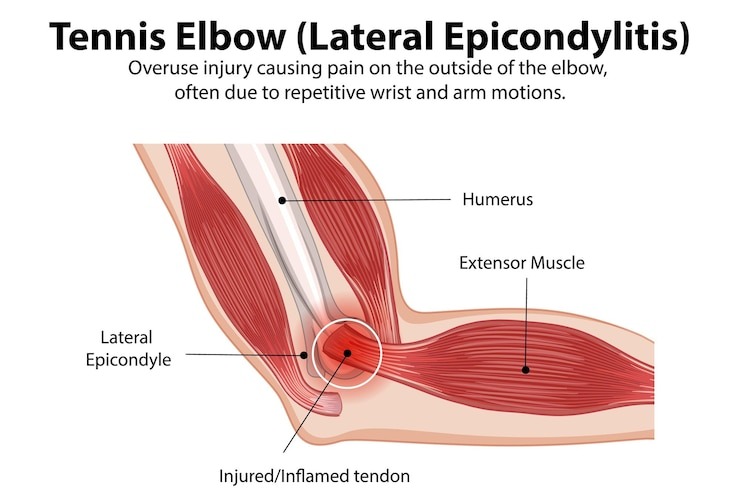Tennis elbow (common extensor tendinopathy or lateral epicondylitis) is a fairly common condition. To understand how much of the UK population suffers from the ailment, let’s look at the below data:
- Per 1000, only 4-7 are affected by tennis elbow
- This accounts for about 1-3% of the population
- Those aged between 35-54 are usually affected
This affects people notwithstanding their lifestyle. Those diagnosed may recover between 1-2 years, with the recovery percentage ranging between 80 and 90%.
After your diagnosis of tennis elbow is confirmed, the doctor will recommend treatment methods along with pain management techniques. For instance, in case of severe pain, cortisone injection for tennis elbow might be recommended to provide relief. However, seek medical advice before getting started on steroids.
What is Tennis Elbow?

Every 2 out of 3 cases of elbow pain is due to lateral epicondylitis.
Tennis elbow’s exact cause is unknown. But, it most commonly results from strain caused by:
- Repetitive motion of the wrist or arm
- Overuse of the elbow tendons and muscles
Despite its name, tennis elbow is not limited to tennis players, who account for surprisingly few patients of this condition. It can affect anyone whose profession requires repetitive hand movements, such as plumbers, carpenters, and cooks.
Affected body parts include:
- Outer arm
- Elbow
This may cause pain, weakness, reduced range of motion, and difficulty in gripping objects.
The dominant arm is generally affected by tennis elbow.
Home Tests for Tennis Elbow
Do you find it difficult to perform routine activities due to pain in your arm? If you suspect tennis elbow, try the following home tests:
- Stretch your arm
- Elevate it
- Make a fist and apply pressure
- Grip a tool or any object
- Try to lift it
- Check your elbow for
- Swelling
- Tenderness
If doing the above is difficult or sends shooting pain through your arm, there is a chance that you have tennis elbow. Visit your doctor to get an accurate diagnosis.
Common Symptoms of Tennis Elbow
The most commonly observed symptoms among patients are:
- Acute pain in your elbow
- Pain radiating from your elbow to the forearm and wrist
- Difficulty in holding/gripping an object
- Loss in range of motion
- Swelling and stiffness
- Inability to straighten the arm
Common Causes of Tennis Elbow
The exact cause of tennis elbow is unknown. It is believed to be usually caused by routine activities that involve repetitive motions:
- Typing
- Knitting
- Using power tools and hand tools
- Painting
- Cooking
- Elbow trauma
- Certain sports (e.g., tennis, racquetball, squash)
Risk Factors for Tennis Elbow
Certain factors increase your chances of getting tennis elbow:
- Pre-existing arthritis
- Any other pre-existing condition that causes muscle irritation and inflammation
- Smoking
- Being above the age of 40
- Being overweight
- Certain occupations or hobbies (painting, cooking, playing tennis/squash)
However, it is necessary to note that tennis elbow might appear without any of the above risk factors being present.
How is Tennis Elbow Diagnosed?
A combination of medical diagnostic measures is used to identify tennis elbow in patients:
- Physical examinations like checking your elbow and the mobility of your arm
- Ultrasonography
- X-rays
- Electromyography to detect nerve problems
- Bone Scan
How is Tennis Elbow Treated?

While both surgical and non-surgical methods are available, targeted treatment plans for tennis elbow are designed after an evaluation of:
- Severity
- How old the symptoms are
- Underlying medical conditions
- Physical health
- Medical history
- Pain and pain tolerance level
Non-surgical
When caught at an early stage, non-intrusive ways to increase mobility and induce blood flow are employed to treat tennis elbow. The methods include:
- Regular physical therapy and exercise
- Extracorporeal shockwave therapy
- PRP injections
- Using an ultrasound-guided needle to increase blood flow
- Botox shots
However, accounting for the severe pain, it is essential to maintain a pain management plan. Cortisone injections, NSAIDs, and resting and icing form an essential component of treatment.
Surgical
This is done for two types of patients:
- For whom non-surgical methods have failed
- When symptoms are severe and cannot be managed without surgical intervention.
The usual methods are:
- Open surgery
Cutting the area to remove damaged tendons. This promotes blood flow and healing.
- Arthroscopic surgery
Using a camera and a few minor cuts to guide the process.
For post-surgical recovery, your doctor may prescribe a cortisone injection to manage pain.
Pain Management
An essential step to dealing with any sports injury is effective pain management.
To combat the pain that stops you from doing your daily tasks, try the following:
- Ice the area
- Refrain from activities that worsen symptoms
- Wear an elbow clasp to absorb muscle stress from strenuous activities
- Take NSAIDs
- Steroid injections can also be taken with a prescription
How Do Cortisone Injections Help?
For moderate to severe cases, ultrasound-guided cortisone injection for tennis elbow has a very high efficacy in pain management.
These injections consist of cortisone and a local numbing agent, and are delivered into or around the muscles of the most painful area. These are fast-acting; you will start to see effects in 1-3 days from taking the shot.
Even though cortisone injections are given when pain from tennis elbow becomes unmanageable with conventional therapy, these are not painkillers. These reduce the inflammation that accompanies tennis elbow, thus alleviating pain. So, cortisone injections for tennis elbow don’t just treat the symptom, but the pathology.
Cortisone is an effective management technique for tennis elbow. By reducing the pain and the inflammation, it restores movement and allows a return to normal life. These remain effective for at least three months, but some studies suggest their efficacy may last longer.
It is important to note that steroid injections are most effective when they are followed up with appropriate physical therapy and rehabilitation exercises.
To Conclude
The simplest three-step treatment method for tennis elbow includes:
- Applying ice or a cold compress
- Taking cortisone injection
- Regular exercise and physio
While injuries might seem minor, it is best not to take them lightly. Seek early medical advice, and get your doctor to prescribe you a suitable treatment plan. This may include both physio and prescription meds.
When suffering from severe pain, taking a cortisone injection might work best. Your doctor will assess your pain level decide and the best course of action.
Visit our home-page for more informations
